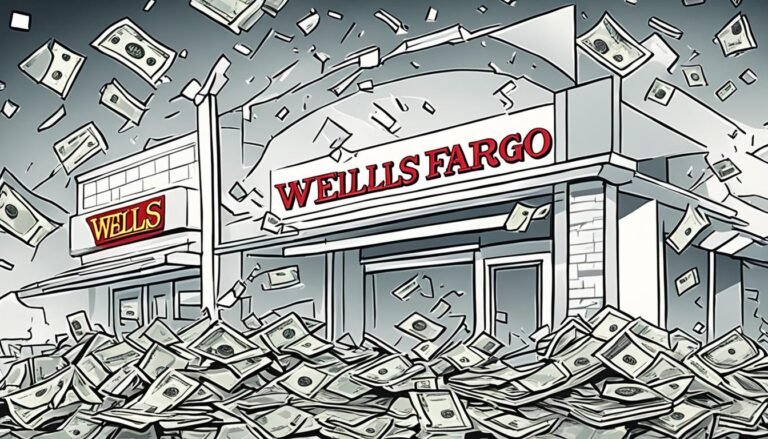JPMorgan Chase’s London Whale: A Case Study in Market Risk
Welcome to our article on JPMorgan Chase’s London Whale scandal, a fascinating case study in market risk and financial risk management. In this article, we will delve into the details of this infamous incident and explore the key lessons learned from it.
Key Takeaways:
- The London Whale scandal at JPMorgan Chase serves as a case study in market risk analysis and financial risk management.
- The incident highlighted the importance of robust risk management practices in the financial industry.
- JPMorgan Chase’s risk management practices at the Chief Investment Office (CIO) were found to be lacking in comparison to other business units within the bank.
- The failures in risk management included inadequate risk assessment, monitoring, and control of high-risk trading activities.
- The incident led to increased scrutiny of risk management practices and regulatory reforms in the financial industry.
Introduction to the London Whale Scandal
The London Whale scandal, involving JPMorgan Chase, was a major event that unfolded in December 2011. It revealed serious failures in risk management within the bank, resulting in significant losses and widespread repercussions. The incident centered around JPMorgan Chase’s Chief Investment Office (CIO) and its Synthetic Credit Portfolio (SCP) traders.
In response to instructions to reduce the size of the SCP, the traders executed a series of trades that ultimately led to enormous losses. By December 2012, the losses had reached a staggering $6.2 billion. The London Whale scandal serves as a stark reminder of the critical importance of effective risk management practices in the financial industry.
The Role of JPMorgan Chase
“Risk comes from not knowing what you’re doing.”
– Warren Buffett
JPMorgan Chase, as one of the largest banks in the United States, is expected to uphold strong risk management practices. However, the London Whale scandal exposed significant deficiencies in risk management within the bank’s CIO. These failures revealed vulnerabilities that led to substantial financial losses and damaged the bank’s reputation.
The incident served as a wake-up call for the importance of robust risk management and highlighted the need for enhanced oversight and accountability within financial institutions. It also ignited discussions about regulatory reforms and the stability of the global financial system.
| Key Lessons from the London Whale Scandal |
|---|
| 1. Risk management failure: The scandal exposed a critical breakdown in risk management practices within JPMorgan Chase’s CIO. It underscored the need for a comprehensive and proactive approach to identify, assess, and mitigate risks. |
| 2. Inadequate oversight: The incident shed light on the importance of robust supervisory oversight in the financial industry. It raised concerns about the effectiveness of regulatory frameworks and the need for stronger mechanisms to prevent and detect risky behaviors. |
| 3. Repercussions on reputation: The London Whale scandal significantly impacted JPMorgan Chase’s image and public perception. It eroded trust among stakeholders and highlighted the importance of maintaining integrity and transparent communication in preserving reputation. |
| 4. Impetus for risk management reforms: The incident prompted JPMorgan Chase to implement remedial measures, enhancing risk management practices and governance across the organization. It also sparked broader discussions about industry-wide risk management reforms. |
The London Whale scandal serves as a cautionary tale and a catalyst for change in the financial industry. It reinforces the vital role of risk management in ensuring the stability and security of institutions and the global financial system as a whole.
JPMorgan Chase’s Risk Management Practices
JPMorgan Chase, a prominent player in the financial industry, has long been recognized for its commitment to risk management. After weathering the storm of the 2007-2009 financial crisis, the bank prioritized strengthening its risk management practices to ensure the stability and security of its operations.
However, despite its overall reputation for robust risk management, the London Whale incident shed light on deficiencies within JPMorgan Chase’s risk management practices, particularly within the bank’s Chief Investment Office (CIO). The CIO, where the incident took place, was found to have inadequate risk management measures compared to other business units within the bank.
This revelation was surprising, considering JPMorgan Chase’s history of prudence and caution. The London Whale incident exposed the vulnerabilities within the bank’s risk management framework and highlighted the need for greater scrutiny and improvement in this critical area.
Ensuring effective risk management practices is not only crucial for the stability of financial institutions but also for the protection of customer interests and the overall health of the financial industry. JPMorgan Chase’s experience serves as a reminder that even the most reputable institutions must consistently evaluate and enhance their risk management strategies to adapt to evolving market dynamics.
Let us further examine the specific areas where JPMorgan Chase’s risk management practices were found to be lacking in the context of the London Whale scandal.
The Role of Risk Management in the Financial Industry
In the complex and fast-paced world of finance, risk management plays a critical role in identifying, assessing, and mitigating potential hazards and uncertainties. Effective risk management is essential for maintaining the stability and sustainability of financial institutions and safeguarding the interests of shareholders, clients, and the broader financial system.
A robust risk management framework involves comprehensive risk identification, thorough evaluation, and the implementation of appropriate risk mitigation strategies. It is an ongoing process that requires vigilant monitoring and continuous improvement to address emerging risks and challenges.
JPMorgan Chase’s Risk Management Framework
Prior to the London Whale incident, JPMorgan Chase had established a reputation for its risk management capabilities, enhancing its practices in the aftermath of the global financial crisis. The bank’s risk management framework encompassed various components, including:
- Comprehensive risk assessment and quantification
- Clear risk appetite and limits
- Robust internal controls and compliance procedures
- Ongoing risk monitoring and reporting
- Regular stress testing to assess resilience
However, the risk management practices within the bank’s CIO, responsible for managing the Synthetic Credit Portfolio, failed to live up to the bank’s overall standards. This failure created vulnerabilities that were exploited by the traders involved in the London Whale trades.
Deficiencies in Risk Management Practices
The shortcomings in JPMorgan Chase’s risk management practices, particularly within the CIO, were identified during the post-incident investigations. The following deficiencies were found:
- Lack of independent risk oversight: The CIO lacked an independent risk management function, which allowed traders to operate without adequate checks and balances.
- Inadequate risk measurement and modeling: The models used to assess the potential risks associated with the Synthetic Credit Portfolio were deemed inadequate, failing to capture the full extent of potential losses.
- Insufficient risk reporting and communication: There were breakdowns in risk reporting and communication, hindering effective decision-making and escalating the extent of the losses incurred.
- Overreliance on historical data: Risk models heavily relied on historical data, failing to account for the changing market conditions and the complexities of the trades undertaken by the CIO.
These deficiencies collectively contributed to the failure of risk management within the CIO, leading to substantial financial losses and reputational damage for JPMorgan Chase.
| Risk Management Deficiencies | Impact |
|---|---|
| Lack of independent risk oversight | Allowed traders to bypass risk controls, leading to excessive risk-taking. |
| Inadequate risk measurement and modeling | Underestimated risks, leading to inaccurate risk assessments and losses. |
| Insufficient risk reporting and communication | Delayed recognition and escalation of risks, impeding effective decision-making. |
| Overreliance on historical data | Failed to capture changing market dynamics and associated risks accurately. |
Facing the consequences of these deficiencies, JPMorgan Chase recognized the need for immediate remedial actions to reinforce its risk management capabilities and prevent similar incidents in the future. The bank undertook significant measures to enhance risk management practices, incorporating lessons learned from the London Whale scandal.
The image above visually represents the key components of JPMorgan Chase’s risk management practices before and after the London Whale incident. By analyzing the changes implemented by the bank, we can better understand the importance of continually strengthening risk management frameworks in the dynamic and complex landscape of the financial industry.
The Role of the Chief Investment Office
The Chief Investment Office (CIO) at JPMorgan Chase plays a critical role in managing the bank’s excess deposits and mitigating risks associated with borrower default and other factors. The CIO’s primary objective is to ensure the bank’s capital is invested effectively, while also implementing risk mitigation strategies.
One important aspect of the CIO’s responsibilities is the management of credit derivatives, which are financial instruments used to hedge against potential credit losses. Credit derivatives provide a means for the bank to transfer credit risk to other parties, reducing the overall exposure of the institution.
The CIO’s investment strategy is designed to offset the default risk faced by the bank. However, the Synthetic Credit Portfolio (SCP), which was managed by the CIO, deviated from its original purpose and became a complex trading strategy focused on generating profits rather than strictly mitigating risk.
“The CIO’s primary goal is to invest the bank’s excess deposits and hedge risks associated with borrower default and other factors.”
This shift in strategy led to the accumulation of large positions in high-risk credit derivatives, which ultimately resulted in substantial losses for JPMorgan Chase. The CIO’s failure to prioritize risk mitigation in their trading activities highlighted the importance of effective risk management practices and oversight within financial institutions, including robust risk assessment and limits.
The London Whale incident served as a wake-up call for JPMorgan Chase and the broader financial industry, leading to a reevaluation of risk management practices and the recognition of the critical role of the CIO in maintaining stability and mitigating risk within the institution.
Risk Mitigation and the SCP
The SCP was initially established as a tool for risk mitigation, designed to offset the default risk faced by JPMorgan Chase by diversifying its credit exposure. It utilized credit derivatives, such as credit default swaps, to hedge against potential losses.
However, over time, the SCP deviated from its intended purpose and took on a speculative nature, focusing on profit generation rather than risk mitigation. Complex trading strategies and large positions in credit derivatives were employed, exposing the bank to significant market risks.
The Importance of Effective Risk Management
The London Whale incident underscored the importance of effective risk management practices within financial institutions. It highlighted the need for clear risk assessment frameworks, robust internal controls, and stringent risk limits to prevent excessive risk-taking.
“The London Whale incident emphasized the necessity of effective risk management practices and strong oversight within financial institutions.”
It became evident that the CIO’s lack of risk awareness and control mechanisms resulted in substantial losses and damaged the bank’s reputation. This incident prompted JPMorgan Chase and other financial institutions to implement stronger risk management protocols and enhance regulatory oversight to prevent similar occurrences in the future.
The Failures in Risk Management
JPMorgan Chase’s risk management system suffered significant failures in assessing and controlling the risks associated with the Synthetic Credit Portfolio (SCP), ultimately leading to the London Whale scandal. The traders involved in the notorious trades engaged in high-risk activities that were inadequately monitored and controlled.
The risk management team at JPMorgan Chase failed to perform a thorough risk assessment of the SCP, underestimating the potential losses that could occur. This failure in risk assessment left the bank ill-prepared to manage the escalating risks and exposed it to substantial financial losses.
“Risk management requires a comprehensive understanding of the potential risks and their limits. In the case of the London Whale scandal, the risk management failures allowed for unchecked trading activities that ultimately resulted in significant losses.”
The risk limits established by JPMorgan Chase were not effectively enforced, allowing the traders to engage in increasingly high-risk trading strategies that deviated from the intended risk mitigation approach. The lack of proper risk limits and controls enabled the traders to take excessive risks without adequate oversight or intervention.
The failures in risk management can be attributed to several factors, including inadequate risk assessment methods, ineffective monitoring systems, and a lack of accountability within the risk management team. These deficiencies allowed for the accumulation of large, concentrated positions in the SCP, exacerbating the potential risk exposure.
Impact of Risk Management Failures:
The consequences of these risk management failures were significant. JPMorgan Chase incurred billions of dollars in losses, resulting in reputational damage and a loss of investor confidence. The London Whale scandal also exposed weaknesses in JPMorgan Chase’s risk management practices and raised concerns about the overall effectiveness of risk management in the financial industry.
Risk management failures, such as those seen in the London Whale incident, serve as a reminder of the critical importance of robust risk assessment practices and effective risk limits. Without proper risk management protocols in place, financial institutions are vulnerable to excessive risk-taking and potential catastrophic losses.
Lessons to be Learned:
The London Whale scandal highlights the need for financial institutions to prioritize risk assessment and management practices. It is crucial for organizations to implement robust risk assessment methods, establish and enforce appropriate risk limits, and ensure effective monitoring and control mechanisms are in place.
Furthermore, risk management should be a collective responsibility within organizations, with clear lines of accountability and oversight. Regular evaluation of risk management practices and continuous improvement are essential to prevent future risk management failures.
“Proper risk assessment and management are vital for the stability and resilience of financial institutions. By learning from the failures in risk management, organizations can strengthen their risk management practices and avoid similar incidents.”
Regulatory Oversight and Consequences
The London Whale incident shed light on the concerning issues surrounding regulatory oversight and reporting within the financial industry. The consequences resulting from the failure to accurately report the risks and losses associated with the Synthetic Credit Portfolio (SCP) trading activities were far-reaching and raised significant concerns about the effectiveness of regulatory supervision and accountability.
“The lack of supervisory oversight and the failure in regulatory reporting exposed a critical vulnerability in the financial system.”
The incident highlighted the need for enhanced supervisory oversight to ensure that financial institutions accurately report their risk positions and adhere to regulatory guidelines. The detrimental impact of inadequate oversight and reporting can be observed in the significant losses incurred by JPMorgan Chase, ultimately amounting to $6.2 billion.
Moreover, the consequences of the London Whale incident extended beyond financial losses. The incident tarnished JPMorgan Chase’s reputation and eroded public trust in the bank’s risk management practices. It also raised concerns among investors, regulators, and the general public regarding the overall stability and integrity of the financial industry.
Accountability and Regulatory Reforms
The London Whale incident served as a wake-up call for regulators, prompting them to reassess the efficacy of existing supervisory frameworks. Regulatory authorities implemented a range of reforms aimed at strengthening oversight and improving reporting standards to prevent similar incidents in the future.
The consequences of the incident also highlighted the significance of accountability within the financial industry. Regulatory bodies imposed penalties and fines on JPMorgan Chase, holding the bank accountable for its failure to adequately manage risks and provide accurate reports. This reinforced the importance of transparency and integrity in risk management practices across all financial institutions.
Lessons Learned
The London Whale incident underscored the need for robust and effective regulating bodies that are capable of detecting and mitigating risks within the financial industry. Supervisory oversight should be proactive, ensuring that institutions operate within established risk limits and report their activities accurately.
“Effective regulatory oversight is crucial to maintaining the stability and integrity of the global financial system.”
Furthermore, the incident emphasized the importance of robust internal controls and risk management practices within financial institutions. Risk assessments and reporting mechanisms should be comprehensive, providing a clear and accurate picture of the institution’s risk exposure.
The consequences of the London Whale incident continue to shape regulatory reforms, placing greater emphasis on transparency, accountability, and risk management practices. By learning from past mistakes, the financial industry can work towards a more secure and resilient system for the benefit of all stakeholders.
Lessons Learned and Remedial Measures
The JPMorgan Chase London Whale scandal served as a wake-up call to the financial industry, highlighting the critical importance of effective risk management practices and stronger regulatory oversight. This section explores the key lessons learned from the incident and the remedial measures implemented by JPMorgan Chase to enhance risk management across the organization.
Risk Management Lessons
The London Whale incident revealed several crucial risk management lessons that have echoed throughout the industry. One of the key takeaways is the need for comprehensive risk assessments to identify and quantify potential risks accurately. It became evident that relying solely on standard risk models without considering the impact of extreme market conditions can lead to severe consequences. Risk managers must adopt a proactive approach to anticipate and address emerging risks before they escalate.
Furthermore, the incident emphasized the significance of setting and enforcing robust risk limits. JPMorgan Chase’s failure to establish and maintain appropriate risk limits allowed traders to engage in high-risk trading activities that exceeded acceptable boundaries. Risk managers must monitor and enforce risk limits consistently to prevent excessive risk-taking and maintain the stability of financial institutions.
Remedial Measures
In response to the London Whale incident, JPMorgan Chase took several remedial measures to strengthen its risk management framework and prevent similar incidents from occurring in the future.
Firstly, JPMorgan Chase revised its risk governance structure, ensuring clearer lines of responsibility and accountability within the organization. This restructuring aimed to enhance risk oversight and facilitate timely decision-making processes.
The bank also bolstered its risk assessment methodologies by incorporating stress testing scenarios that simulated extreme market conditions. This approach enabled risk managers to better understand the potential impact of volatile market environments and make informed risk management decisions.
Additionally, JPMorgan Chase implemented enhanced risk monitoring systems and controls. These systems provide real-time data and analytics to risk managers, enabling them to detect and address potential risk factors promptly. Improved risk monitoring promotes proactive risk mitigation and reduces the likelihood of future incidents.
Furthermore, JPMorgan Chase prioritized the development of comprehensive risk training programs for its employees. These programs aimed to improve risk awareness and the understanding of complex financial instruments. By enhancing risk literacy across the organization, JPMorgan Chase sought to foster a risk-aware culture that empowers employees to identify and address potential risks in their respective roles.
In conclusion, the London Whale scandal served as a catalyst for significant changes in risk management practices within JPMorgan Chase. The incident highlighted the need for improved risk assessments, robust risk limits, and enhanced risk monitoring systems. By implementing these remedial measures, JPMorgan Chase strives to create a more resilient and proactive risk management culture that ultimately safeguards the institution and the broader financial industry.
Impact on JPMorgan Chase and the Financial Industry
The London Whale scandal had far-reaching consequences, impacting not only JPMorgan Chase but also the reputation of the entire financial industry. The revelation of significant financial losses and inadequate risk management practices damaged JPMorgan Chase’s standing among investors, regulators, and the general public.
The incident brought increased scrutiny to the risk management practices employed by financial institutions, highlighting the need for more robust measures to prevent similar incidents in the future. The London Whale scandal served as a wake-up call, exposing vulnerabilities within the financial industry’s risk assessment, enforcement, and regulatory frameworks.
The magnitude of the losses and the subsequent loss of confidence in JPMorgan Chase’s risk management practices exposed the potential for severe damage when risk management is inadequate. The reputation damage suffered by JPMorgan Chase reverberated throughout the financial industry, raising questions about the effectiveness of risk management practices across the board.
The fallout from the London Whale scandal prompted reforms in the financial industry’s risk assessment and supervision. Regulators and policymakers introduced stricter risk management requirements and enhanced oversight across banks and financial institutions. These reforms aimed to strengthen risk management practices, prevent future large-scale losses, and protect the stability of the financial system as a whole.
Overall, the London Whale scandal left a lasting impact on JPMorgan Chase and the financial industry, leading to a deeper focus on risk management reforms and a commitment to building more resilient and accountable institutions.
Cross-Border Regulation and International Implications
The international nature of the London Whale incident has brought to the forefront the urgent need for improved coordination and cooperation in cross-border regulation. The incident’s ripple effects in global financial markets have raised significant questions about the stability and resilience of the global financial system.
The interconnectedness of financial institutions across multiple jurisdictions emphasizes the importance of cross-border regulation to prevent and mitigate risks. Inadequate regulatory frameworks and insufficient oversight can create loopholes and vulnerabilities that can be exploited, leading to severe consequences for the global financial system.
When it comes to managing cross-border risks, international cooperation among regulatory bodies is vital. Harmonizing regulatory approaches and sharing information can enhance transparency, identify potential risks, and enforce consistent standards. Close collaboration between regulatory authorities can help prevent a recurrence of incidents like the London Whale scandal.
“The London Whale incident serves as a wake-up call for cross-border regulators to reassess their collaboration efforts and develop stronger frameworks to address global financial risks.”
Furthermore, the incident highlights the need for effective risk assessment and management practices across multinational financial institutions. Robust risk management frameworks should encompass not only individual institutions but also consider the broader systemic implications.
Table: International Implications of the London Whale Incident
| Implication | Description |
|---|---|
| Loss of investor confidence | The incident shook investor confidence in the stability and risk management practices of global financial institutions. |
| Reputational damage | JPMorgan Chase’s reputation was severely impacted, leading to decreased trust in the institution. |
| Increased regulatory scrutiny | Regulatory authorities globally intensified their scrutiny on risk management practices and reporting standards. |
| Stricter cross-border regulations | The incident highlighted the importance of strengthening cross-border regulations to address systemic risks. |
| Calls for international coordination | The incident sparked calls for improved coordination and information sharing among global regulatory bodies. |
It is crucial for regulators, policymakers, and financial institutions to work together to address the challenges posed by cross-border risks. Robust cross-border regulation and effective international cooperation are necessary to safeguard the stability and integrity of the global financial system.
Conclusion
The JPMorgan Chase’s London Whale scandal serves as a significant case study in market risk analysis and highlights the urgent need for robust risk management practices in the financial industry. This incident exposed the weaknesses in JPMorgan Chase’s risk management system, leading to massive losses and severe consequences.
The lessons learned from the London Whale incident have had a lasting impact on risk management reforms and regulatory oversight efforts. Financial institutions have recognized the critical importance of effective risk assessment, mitigation strategies, and appropriate risk limits to safeguard against such catastrophic events.
Market risk analysis has become a vital component in financial institutions’ risk management frameworks. The London Whale scandal has shed light on the importance of accurately assessing and managing market risks, ensuring that risk-taking activities align with risk appetite and regulatory requirements. By learning from this incident, organizations can implement robust risk management practices to mitigate potential losses and protect their stakeholders.








